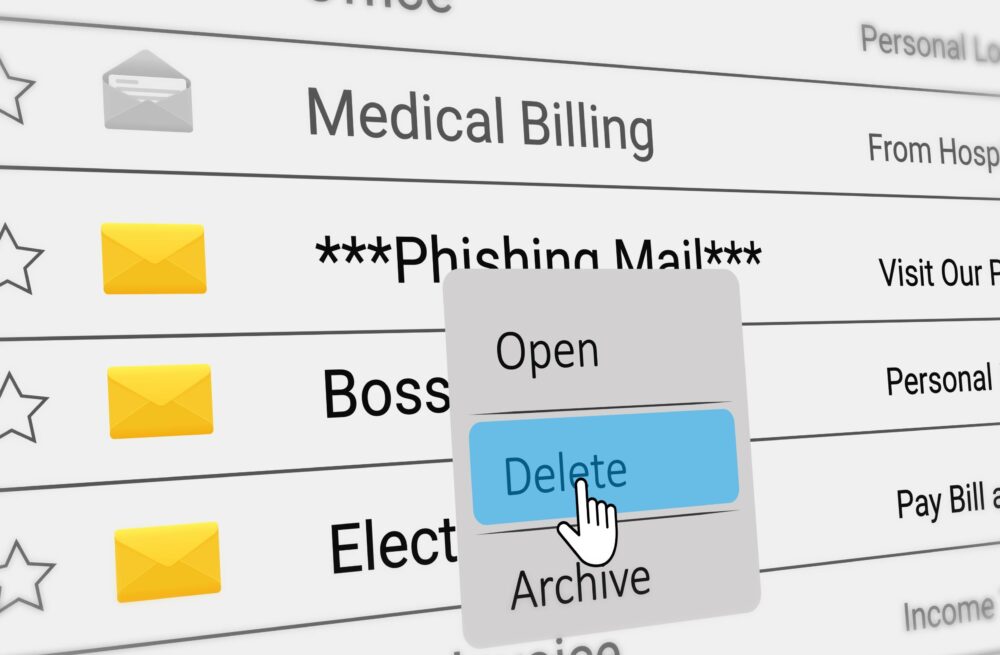Phishing attacks continue to top the list of the most common cybercrimes for one simple reason—they’re effective. Every day, over 3.4 billion spam emails flood inboxes worldwide, targeting unsuspecting users. These attacks persist because they’re not only easy to scale, but cybercriminals are also leveraging AI tools like ChatGPT to craft emails that mimic human communication with increasing sophistication. The consequences of falling victim to these scams can be devastating.
As we mark Cybersecurity Awareness Month, it’s important to shine a light on phishing attacks, which remain one of the biggest threats to businesses today. Understanding the risks and knowing how to spot a phishing email are critical steps in protecting your organization.
The Risks of Phishing Attacks: 4 Key Dangers
1. Data Breaches
Phishing attacks can open the door to sensitive company data being stolen. Once hackers gain access, they can sell it on the dark web or demand a ransom for its return—though in many cases, the data may never be restored. This puts your organization at risk of financial losses, legal issues, damaged reputation, and lost client trust.
2. Financial Losses
Cybercriminals frequently use phishing scams to execute fraudulent transactions or trick businesses into paying fake invoices or changing bank account information. A single phishing email can wreak havoc on your financial standing, wiping out significant amounts from your company’s bottom line.
3. Malware Attacks
Phishing emails often come with malicious attachments or links that infect systems with malware when clicked. These infections can disrupt your operations, corrupt data, and cost your business time and money in repairs and recovery.
4. Account Compromises
If an employee falls for a phishing scam, their account may be compromised, allowing attackers to escalate the attack or gain unauthorized access to critical systems. This can lead to further breaches by establishing invisible long term access to company data, exacerbating the damage.
While the list of risks goes on, there are steps you can take to avoid becoming the next victim of a phishing scam.
How to Stay S.E.C.U.R.E. – 6 Key Tips for Spotting Phishing Emails
You and your employees can use the S.E.C.U.R.E. method to easily identify phishing emails and prevent falling prey to cybercriminals.
•S – Scrutinize the Subject Line: Does the subject line seem off? Watch for red flags like odd formatting or urgency cues such as “URGENT: Action Needed” or excessive “FWD” markers.
•E – Examine the Sender’s Email Address: Look closely at the sender’s address. Is it a recognized contact, or is it slightly misspelled? Be cautious of unfamiliar or suspicious domains.
•C – Check the Greeting: Is the salutation generic or overly formal, like “Dear Sir/Madam” or “Hello Ma’am”? A greeting that feels impersonal or odd is often a sign of phishing.
•U – Uncover the Message’s Intent: Does the email push urgency or try to entice you with an unrealistic offer? Phishing emails often rely on creating a sense of panic or excitement to trick people into clicking on a link or downloading an attachment.
•R – Review for Errors: Many phishing attempts are filled with grammar mistakes, awkward phrasing, or spelling errors. Legitimate business communications are typically more polished.
•E – Evaluate Links and Attachments: Before you click any link, hover over it to inspect the actual URL. If the link doesn’t seem right or it’s unfamiliar, don’t click it. Similarly, avoid opening unexpected attachments.
Protect Your Organization with Professional Cybersecurity
Preventing phishing attacks starts with awareness, regular training of employees, and conducting regular phishing attack simulations but it doesn’t stop there. It’s also essential to have experts managing your network, monitoring suspicious activity, and blocking threats before they reach your employees. Ensuring that your cloud email environment is monitored by the same experts that monitor the rest of your infrastructure is key.
Don’t wait until it’s too late. If you need assistance training your team, enhancing your cybersecurity infrastructure, or assessing your current systems for vulnerabilities, we’re here to help. Reach out to us at 856-552-3535 or click here to schedule a no obligation discussion with our team.
Stay vigilant, stay prepared, and stay S.E.C.U.R.E.







